Birds of New Zealand facts for kids
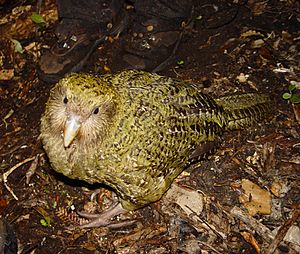
New Zealand is home to many unique birds, meaning they are found nowhere else in the world. Because New Zealand is a group of islands, it has developed a huge variety of birds. When Captain James Cook visited in the 1770s, he wrote that the bird songs were incredibly loud!
Some birds have very special ways of life. For example, the kākāpō is the only parrot in the world that cannot fly and is active at night. It also has a unique way of finding a mate. Many New Zealand birds are similar to those in nearby countries. Over millions of years, birds have arrived, changed, and sometimes disappeared. Some species arrived recently, even after humans, while others have been there for a very long time.
Contents
New Zealand Birds: A Look at Their History After Human Arrival
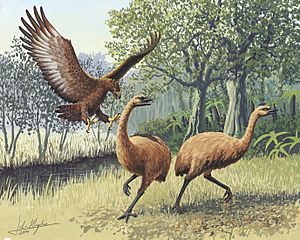
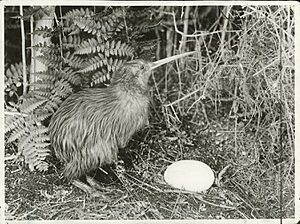
About 700 years ago, when the Māori people arrived in New Zealand, the environment changed quickly. Some bird species were hunted until they disappeared, like the huge moa and the powerful Haast's eagle. But the biggest problems came from destroying their homes (habitat) and from animals that humans brought with them.
Rats were a huge problem. The Polynesian rat (kiore) came with the Māori, and later, European settlers brought brown and black rats. Other animals like mice, dogs, cats, stoats, weasels, pigs, goats, deer, hedgehogs, and Australian possums also harmed native birds.
Birds that couldn't fly were especially in danger. Birds like the kākāpō and kiwi couldn't fly away from predators. They also couldn't lay their eggs in high, safe places. This made their eggs easy targets for animals like stoats and weasels.
Because of these changes, many bird species became extinct. Others are now critically endangered, meaning they are very close to disappearing forever. Nearly half of New Zealand's native birds vanished after humans arrived. This was one of the biggest waves of extinctions in history.
Today, some species only live on small islands off the coast. Others live in special "ecological islands" on the mainland. These are fenced areas where all predators have been removed. New Zealand is a world leader in saving endangered species. They create safe places for birds to grow their populations again. These places include 44 marine reserves and 13 national parks. In total, over 100,000 protected areas cover one-third of the country. These safe zones help flightless birds especially, protecting them from hunting and introduced animals.
New Zealand's Unique Birds Compared to the World
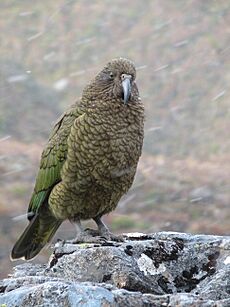
New Zealand plays a big role in the world's variety of birds and other living things. The country has about 80,000 native species of plants and animals. Almost all frogs and reptiles, about 90% of insects, 80% of plants, and 25% of bird species in New Zealand are found only there.
After European settlers arrived, the types of birds changed. Many unique birds were hunted for sport. New animals were brought in to control insects or for hunting. Also, new predators harmed the defenseless New Zealand birds.
New Zealand's birds are split into three main groups: land birds, wetland birds, and seabirds. Each group makes up about one-third of the total bird species in the country. This is different from the rest of the world, where land birds make up 90% of all bird species.
Bird Conservation Efforts in New Zealand

When humans first arrived in New Zealand, there were at least 196 native bird species. This included 131 land, freshwater, and coastal birds, and 65 seabirds. A large number of these, about 59%, were endemic, meaning they lived only in New Zealand.
By 2018, at least 60 bird species had been lost forever. This was mainly due to habitat loss and invasive species. Many more birds are now threatened with extinction. As of 2019, about 74% of New Zealand's land birds are considered threatened or at risk.
Huge efforts are being made to save bird species. These include the takahē, kākāpō, mohua, kōkako, whio, hihi, and the kiwi. One great success story is saving the black robin on the Chatham Islands. Another example is the kiwi and whio. With human help, their nesting and hatching success has greatly improved, from 8–10% to 90%. By building fences to keep predators away or moving predators, kiwi and other birds have been able to grow their populations.
From the time humans first settled until 1994, 41% of all unique New Zealand bird species became extinct. If New Zealand's currently threatened birds disappear, it could take millions of years for nature to bring back that level of variety.
Many groups are working to protect New Zealand's birds. These include non-profit groups and community projects like "Save Our Iconic Kiwi" and the "Takahē Recovery Programme." The Department of Conservation also supports these efforts. They raise money and help people learn about the unique birds. Tourism in conservation areas also helps people understand the importance of saving these animals.
Several laws help protect New Zealand's birds. These include the Conservation Act 1987 and the Wildlife Act 1953. A big new plan is "Predator Free 2050." This plan aims to get rid of introduced predators that threaten native species within half a century.
Predator Free 2050: A Big Plan to Save Birds
In 2016, the New Zealand Government asked the Department of Conservation to create a special program. This program would use knowledge from Māori groups and conservation experts. The "Predator Free 2050 Strategy" started in March 2020. It also included a five-year plan for individuals and groups across the country to follow.
The plan has three main actions:
- Mobilise: This means building communities that work together to become predator-free. It also involves creating partnerships across regions and the whole country.
- Innovate: This focuses on creating new tools and methods to remove predators from New Zealand's natural areas.
- Accelerate: This means using these new tools and methods all over the country as they are developed.
All updates on the program's progress are available to the public. The 2023 update shows good results for the "mobilise" and "innovate" parts of the plan.
Saving the Kiwi: A Case Study
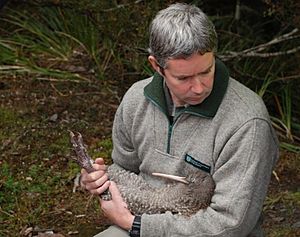
Saving the kiwi is a team effort. The New Zealand government, local communities, and Māori groups all work together. The kiwi is a national symbol, and New Zealanders often call themselves "Kiwis."
Kiwi birds are very important for their environment. They help spread seeds and control insect populations, which helps native plants grow. Before humans arrived, there were an estimated 12 million kiwi. Today, there are only about 70,000. The kiwi population is shrinking by 2% each year, with about 20 kiwi dying every week.
The goal is to increase the Roroa (a type of kiwi) population by at least 2% each year. This is done by controlling predators to help kiwi chicks survive. Without predator control, only about 10% of kiwi chicks survive because of stoats and other mammals.
Before Predator Free 2050, the Kiwi Recovery Plan 2018–2028 was already working to save kiwi. Many of its goals were included in the Predator Free 2050 plan. A kiwi monitoring program has been tracking kiwi since 1992. It shows that chick survival jumped to 50% after pest control and less pesticide use.
The "Save the Kiwi" organization and other research projects have focused on the North Island. This area is a major hub for community-led kiwi conservation. In 2020, 11 projects funded by the organization went beyond their goals for predator control and kiwi rehabilitation. This included controlling mustelids (like stoats) over a huge area of 127,432 hectares.

